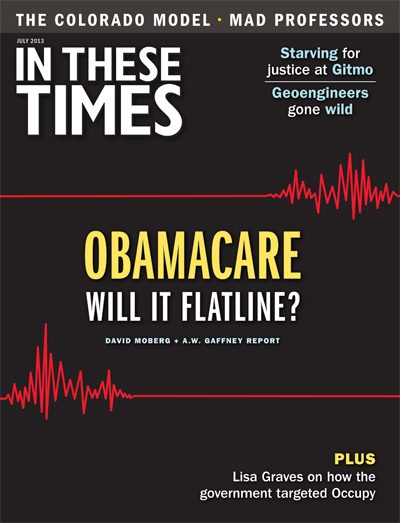The Hundred Years’ War for Healthcare Reform
Until the ACA, reform attempts have been thwarted throughout the last century.
Adam Gaffney

The story of healthcare reform in the United states begins not with Obama, Clinton or even Johnson, but almost a century ago, in the years leading up to World War I. Although the Socialist Party of America had called for insurance for workers “against accident, sickness and lack of employment” as early as 1904, it wasn’t until 1912, when the platform of Theodore Roosevelt’s Progressive Party called for a system of health insurance, that it emerged as a major political issue. Roosevelt lost the election, but progressives were nonetheless optimistic that healthcare legislation could be passed at the state level, and in 1916, progressive state legislators submitted “compulsory” health insurance bills to the legislatures of New York, Massachusetts and New Jersey. Much like the “employer mandate” of the Affordable Care Act, these plans would have required industrial employers to contribute to medical coverage and sick pay for workers and their families.
These were bold ideas, but they met with unfortunate timing, as two developments in Europe furnished powerful ideological weapons to those who opposed the legislation: in April 1917, the United states entered the war against Germany, and the following October, the Bolsheviks seized power in Moscow.
These global events proved politically useful to physicians in the American Medical Association (AMA), who had come to see health insurance legislation as a threat to both their independence and income. The AMA could now paint state-based health insurance as both pro-German (given its roots in Otto von Bismarck’s 19th-century social insurance) and pro-Bolshevik. Though the former claim had far more basis in fact, the latter smear was to prove the more enduring — throughout the healthcare reform debate of 2009-2010, even the most moderate of reform proposals were lambasted as communist by the Right. The effect in 1918 was a turning of the tide against the promising state plans that ended in their total defeat and decades of inaction.
For the next 90-odd years, efforts at sweeping healthcare reform in the United States were a series of failures. New Dealers picked up healthcare reform again in the 1930s, seeking to weave it into the new social safety net. However, fear of the physician lobby — which had flexed its newfound political muscle so effectively in the state-based campaigns of 1916-1918 — encouraged Franklin D. Roosevelt to leave health insurance out of his landmark Social Security Act. Still, over time, Roosevelt leaned toward a system of universal healthcare, arguing in his famous 1944 “Second Bill of Rights” State of the Union Address for the “right to adequate medical care and the opportunity to achieve and enjoy good health.”
Though Roosevelt died the following year, the New Deal conception of universal healthcare lived on in the series of “Wagner-Murray-Dingell” (WMD) health bills of the Truman years. In its 1945 version, the WMD bill would have established universal national health insurance based on the European model. The AMA, still opposed to reform, again won the old-fashioned way, by red-baiting WMD to its grave.
Branding the bill with the hammer and sickle turned the fight over universal healthcare into yet another front of the developing Cold War, so much so that when the Johnson administration again sought to remake American healthcare in the 1960s, it strategically pursued reforms only for those individuals who were the least able to afford medical care and therefore the most politically inoffensive: the poor and the elderly. Thus Medicare and Medicaid were born.
Subsequent decades saw a number of universal healthcare proposals crash and burn: Ted Kennedy’s “health security” plan in 1970, Nixon’s plan in 1974, and Clinton’s in 1993.
This series of missteps and lost opportunities gives a sense of the stakes when the healthcare debate again took center stage after the election of Obama in 2008. But Obama also had to contend with a corporate healthcare industry that had grown enormously in power and influence in the hundred years between the WWI-era campaigns and his first term. Indeed, the relatively crude public relations campaign of the AMA in the 1910s was nothing compared to the massive lobbying machines of the insurance and pharmaceutical industries in the 21st century. These corporate “stakeholders” were to critically influence the terms of the healthcare reform debate of 2009-2010.
For instance, the health insurance lobby agreed to support the elimination of “pre-existing” conditions in exchange for a number of industry-favorable provisions, such as an individual mandate. Similarly, the pharmaceutical lobby agreed to support reform legislation so long as it did not allow Medicare to negotiate directly with pharmaceutical companies over drug prices, a reform that by one estimate could have saved the government between $230 billion and $541 billion over ten years. And there’s no doubt that industry influences limited reform in other, less obvious ways, whether it was the early exclusion a single-payer system or the elimination of a “public option” from the final bill.
But clearly, these various, intertwined historical dynamics — stretching back 100 years — contributed crucially to the final form of the landmark legislation that lay upon Obama’s desk on March 23, 2010.
Adam Gaffney is an Assistant Professor at Harvard Medical School and a pulmonary and critical care physician at the Cambridge Health Alliance.








